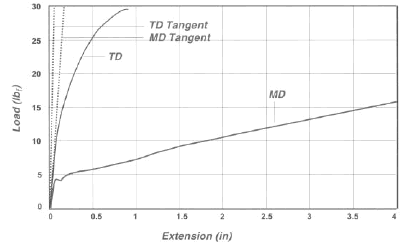Tensiles
Definition
Relevance to performance
What affects a film's tensile properties
Test principles
Related Terminology
Definition
Tensile testers, such as an Instron, measure a film's resistance to being pulled apart at a constant rate of speed. ExxonMobil uses this test to report three significant properties.
- Ultimate tensile strength is the maximum force of resistance divided by the film's initial cross-sectional area. Values are expressed in Ibf/in2 (psi) in US standard units and N/mm2 in metric (SI) units.
- Tensile modulus is a stress-strain ratio calculated from any point on the initial straight line portion of the load-extension curve. It is measured just as the material begins to experience tension. This value is an indicator of the film's stiffness and resistance to elongation in use. The units are Ibf/in2 (psi) and N/mm2.
- Elongation is the percent change in length of the material under stress from start to break. Elongation "at yield" is measured from start to yield point. The units are %.
Relevance to performance
Tensile properties are an important and common way to compare physical properties of diverse materials, from steel to plastic. In the narrower realm of flexible films, these tests provide measurement of attributes we can see and feel: strength, stiffness, and resistance to stretching. Some materials are stronger than others, and some, like polypropylene, can dramatically improve their strength through orientation as shown in Table 3.
| Tensile Property | Cellophane | Oriented PET | Blown LDPE | OPP |
|---|---|---|---|---|
| Ultimate strength (kpsi) | 7-18 | 20-40 | 1.5-4 | 15-40 |
| Elongation (%) | 10-50 | 60-165 | 100-700 | 35-475 |
| Table 3: Typical tensile values for common films* | ||||
| *Although there is a wide range of property values for each material (because of the many choices available in resin formula, processing, and direction of testing), Table 3 shows the characteristic performance range for each type of film. The effect of orientation is reflected in the property differences between cast PP (unoriented polypropylene) and OPP (biaxially oriented polypropylene). | ||||
Within the arena of OPP films, tensiles are generally not critical and rarely require discussion and specification between supplier and customer. This is so because oriented polypropylenes provide a dependable range of tensile values. Other properties are usually more important to successful performance. There are two notable exceptions worthy of explanation.
- Orientation method: blown or tentered
The orientation method causes characteristic differences in tensile properties. Blown films are "balanced," having similar strength and elongation in the machine and transverse film directions. Tentered films (as are all ExxonMobil films) have higher strength and lower elongation in the transverse direction than in the machine direction. Most OPP manufacturers produce tenter-oriented films, which work well in many diverse applications. - Modulus and web tension
Modulus, because it is a measure of strength characteristics in the film's elastic region, provides valuable insight into stiffness and how extensible the film is under normal use tensions. When comparing two films of identical thickness, the one with a higher modulus will be stiffer and stretch less under the same tension force.
NOTE: High temperature modulus testing and empirical trials on converting equipment have yielded an industry rule of thumb: OPP web tensions should be controlled to .50lbf per inch of film width, or less, for good registration and no permanent deformation (elongation, neck-in, gauge bands). From a filmmaker's perspective, the lowest controllable web tension is best. Thinner films and higher converting temperatures make this more critical.
What affects a film's tensile properties
Resin selection and orientation method are the primary variables that influence tensile values. Therefore, tensile properties are almost entirely defined by product design itself. Small variations in tensiles will inevitably result due to normal process variation, but the performance effect is insignificant.
Test principles
Each end of a film specimen, of specific width and measured thickness, is held by a clamp or grip. One grip is stationary, while the other is pulled away from the first at a pre-selected velocity. The machine continuously measures the changing distance between the grips and the force exerted on them as they pull the film apart. The test is completed when the sample breaks.
Today, most machines run automatically after the operator selects settings, loads the specimen, and initiates the test. Most are also equipped with microprocessors that perform the calculations and automatically display all the resulting values. But, the test concepts are best understood by studying load-extension curves like the ones shown in Graph 1. These are actual machine direction (MD) and transverse direction (TD) load-extension curves for a typical, tenter-oriented, 75 gauge OPP. In Graph 1, load is plotted as a function of extension, and the tensile tester software calculates the following properties that are noted in Table 4.
 |
| Graph 1: Typical OPP load-extension curves |
| Results Sample | Sample Description | Thickness (mil) | Ultimate Strength (kspi) | Modulus (kpsi) | Elongation (%) |
|---|---|---|---|---|---|
| 1 | MD pull | .75 | 18.9 | 343 | 174 |
| 2 | TC pull | .75 | 39.3 | 687 | 45 |
| Table 4: Tensile values from Graph 1 | |||||
Table 4 values are software-generated results based on the following equations.
| Ultimate Tensile Strength (psi) = | Max Load (lbf) | = | Max Load (lbf) |
| Initial cross-sectional area | 1 in x .00075 in |
| Modulus (psi) = At any point on the elastic region tangent line (Stress ÷ Strain) = | ||||||
| Load (lbf) | ÷ | Extension (in) | = | Load (lbf) | ÷ | Extension (in) |
| Initial cross-sectional area | Initial grip separation | .00075 in2 | 2 in | |||
| Elongation (% ) = | Extension at failure x 100 | = | Extension at failure x 100 |
| Initial grip separation | 2 in |
Test conditions like pull speed, initial grip separation, full-scale load, and sample width will affect the results. ASTM test procedure D 882 describes a protocol for making choices about these settings. For simplicity and accuracy in comparing values, ExxonMobil uses highly automated tensile testers and has standardized to a particular set-up. These conditions are summarized in Table 5.
Test Condition |
Machine Direction (MD) |
Transverse Direction (TD) |
||||
|---|---|---|---|---|---|---|
| Ultimate Strength | Modulus | Elongation | Ultimate Strength | Modulus | Elongation | |
| Crosshead speed (in/min), i.e. pull velocity |
20 | .5 | 20 | 20 | .5 | 20 |
| Grip separation (in) | 2 | 2 | 2 | 2 | 2 | 2 |
| Sample width (in) | 1 | 1 | 1 | 1 | 1 | 1 |
| Table 5: ExxonMobile standard conditions for tensile testing | ||||||
| ExxonMobil has two test procedures for tensile testing: one for use with Instron equipment (#506) and one for use with Sintech machines (#510). With both tests, the specimen is subjected to identical evaluation conditions. | ||||||
NOTE: The tensile properties for all coated and metallized films are measured on base sheet prior to coating or metallization.
Tensile properties can change with small changes in temperature; so it is important to conduct tests in a controlled environment. Standard laboratory temperature is 72°F (22°C) ± 2°F (1°C).
Related terminology
Young's modulus Modulus of elasticity Tangent modulus: Modulus of elasticity Tangent modulus These are all terms synonymous with tensile modulus, a material property defined as the stress-strain ratio of the initial portion of a load-extension curve. A higher modulus value suggests that this material will be stiffer and have more resistance to elongation in use (when comparing films of the same thickness). Standard units are Ibf/in2 (psi) and N/mm2.
Secant modulus: Secant modulus is an alternate approximation of modulus and better predictor of performance, when there is no straight line portion on the load-elongation curve. It is the stress-strain ratio at the point on the curve that corresponds to a specific designated extension. For example, a 1% secant modulus would be the material's stress/strain, in psi or N/mm2, at the point of extension that is 1% of initial sample length. This can be a useful value, because with no early straight line portion of the curve, the traditional tangent calculation will render a result that predicts the material to be stiffer and less extensible than it really is.
Strain: Strain is the ratio of the change in length of the sample (also called extension) to the original length of the sample. Strain is a unitless value and is converted to % elongation by multiplying by 100.
Stress: Stress is load (Ibf or N) divided by the original cross-sectional area (in2 or mm2) of the specimen. By definition, this value is normalized for gauge.
Yield point: Yield point is the point during the test cycle when the specimen continues to elongate, but there is no increase in load. OPP films typically do not have a clear yield point.

